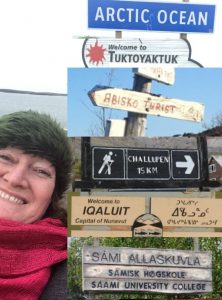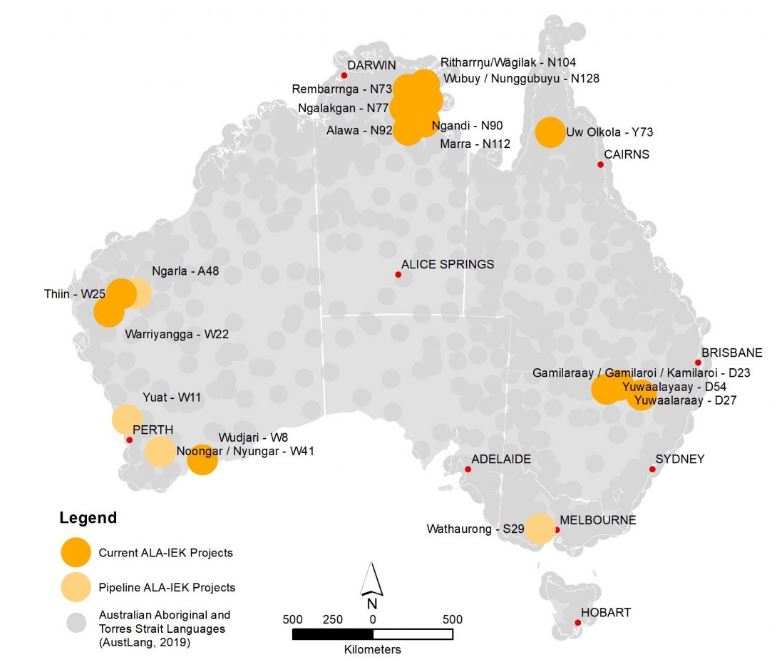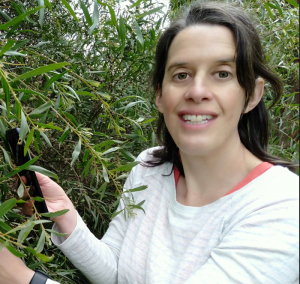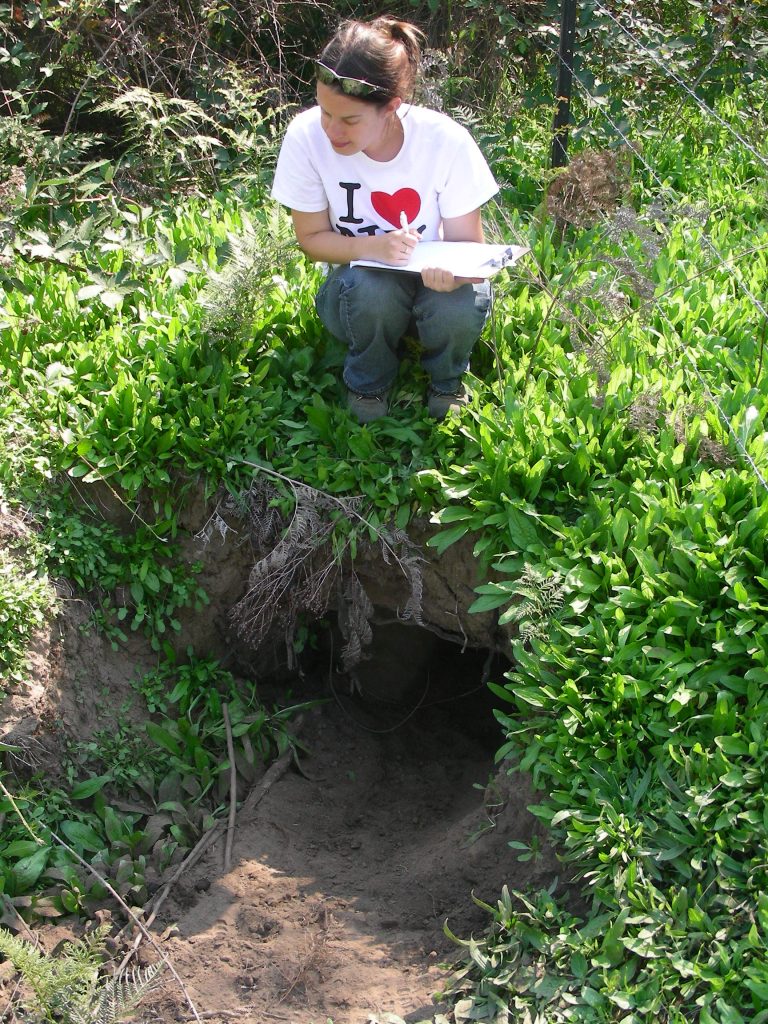The Churchill Fellowship Trust is a highly competitive awards program that provides opportunities for individuals to travel overseas to gain new knowledge and perspectives in their field of work. The Atlas of Living Australia (ALA) is privileged to have two Churchill Fellowship Award recipients, Nat Raisbeck-Brown and Dr Erin Roger. What better way to celebrate International Women’s Day than chatting with both Nat and Erin about their fantastic achievements and to find out more about their Churchill Fellowship projects.
Nat Raisbeck-Brown

Q: What is your role within the ALA and some of your ALA highlights?
I’ve led the Indigenous Ecological Knowledge Program (IEK) within the ALA since 2018. In 2019 we published the first set of Indigenous words in the ALA for the Kamilaroi languages. This was launched at the PULiiMA language and technology conference in Darwin. We have also been working with the Noongar Boodjar Language Centre in Perth, the Irra Wangga Language Centre in Geraldton and the Yugul Mangi Rangers in South East Arnhem Land and have now published more than 3200 language words for approximately 700 species in 12 languages. This work links the traditional knowledge from South East Arnhem Land, Kamilaroi Country and the Noongar Nation to each other. These inter-cultural synchronicities mean for the first time we can compare stories from different cultures and find they are both surprisingly similar and different.
Q; Can you describe your educational and career journey? How did you become interested in pursuing science?
After travelling abroad, I completed my undergraduate degree in Environmental Biology at Curtin University where I discovered a love of Geographic Information System (GIS). I went straight into a Post Graduate Diploma in GIS and have worked in spatial science ever since. I worked for a small mining company and Western Australia’s State Government Land Corporation. I then spent seven years in the Kimberley, working on fire management and running a GIS consultancy and map shop. In that time I did a lot of work and training with Aboriginal people and communities. I started work for CSIRO in 2009 as a GIS projects officer in Agriculture and Ecology and from 2018 have worked with the ALA.
Q: Other than being awarded a Churchill Fellowship, what has been a career highlight for you?
I feel incredibly privileged to be working with Aboriginal people in the collection, protection, promotion and sharing of their knowledge through the ALA IEK program. Another career highlight was working on the creation of the fire information systems, Fire Fax, NAFI and FireWatch with Allan Lawford and his community over the seven years I was in the Kimberley.
Q: Can you describe your Churchill Fellowship project?
My Churchill Fellowship is supporting me to visit First Nations peoples in Canada, the US and Norway to talk about how they are using mapping technologies to collect, protect and share their traditional knowledge. I’ll be travelling through San Francisco to meet with Google Outreach, Vancouver to meet with Indigenous Mapping Workshop founders – Firelight Group, Vancouver Island, Oklahoma, Kansas, Boston, Oslo and Tromso.
Q: How do you believe diversity in science can drive innovation and progress?
It is essential for knowledge to be shared. Aboriginal people have been managing this land for +65,000 year. Now 235 years since colonisation we can see our English-based methods of land and fire management are not appropriate. Science is the platform to bring these two knowledge systems together to ensure we can look after Country into the future.
Q: What advice would you give to young women considering a career in science?
Find strong and trusted allies that can help you navigate the pathway to the career you want. Reach out to people whose work and methods you admire, let them know what you are doing and what you are interested in.

Dr Erin Roger

Q: What is your role within the ALA and how long have you been at CSIRO/ALA?
I’ve been with the ALA now for 2.5 years, but with CSIRO for 3.5 years. I initially joined CSIRO in the Global team but moved to the ALA for an opportunity to support the organisation’s bushfire citizen science response. I currently am the Sector Lead for ALA’s biosecurity and citizen science initiatives.
Q: Can you describe your educational and career journey? How did you become interested in pursuing science?
I’ve always loved the natural environment, I grew up canoe camping with my family in remote areas of Northern Ontario which was formative. I’ve never really known what I wanted to do, but I’ve let my passion and interest in the environment shape my career. That’s resulted in some amazing experiences from aerial moose surveys in Nova Scotia for my Bachelor of Science (Honours) work, modelling wombat presence on the Snowy Mountains Highway for my PhD and working in semi-arid ecology. After university, I became interested in the science-policy interface and joined the New South Wales Environment department to understand science translation. I was lucky enough to have several roles; one of which led me to thinking about how to engage a broader cohort of people in science via citizen science to drive impact. That interest then led me to the ALA.

Q: Other than being awarded a Churchill Fellowship, what has been a career highlight for you?
I attended a United Nations Science-Policy Business meeting in Nairobi as well as the International Union for Conservation of Nature conference in Hawaii as part of a delegation. My highlight though is just the diversity of experiences I’ve had throughout my career ranging from remote field work to getting to meeting diverse people while being involved in challenging and interesting work.
Q: Can you describe your Churchill Fellowship project?
My Churchill Fellowship project is related to what I do at the ALA. I’m interested in how to engage communities in biosecurity surveillance, essentially getting more eyes and ears on the ground. There are some great examples globally we can learn from. I’ve set a bit of a whirlwind schedule travelling to New Zealand, Samoa, the US, Denmark, Belgium, and the UK. I have a range of meetings lined up including Indigenous leaders, government, NGOs and academics.
Q: How do you believe diversity in science can drive innovation and progress?
More diverse teams can shape research priorities and challenge norms. The more people involved lead to a diversity in thinking of how problems are represented and solved. Citizen science is a great way to increase diversity, but it also comes with challenges like thinking through ethics, proper attribution, exploitation and ensuring a diversity of communication methods. These considerations aren’t just unique to citizen science and can be used to inform STEM development more broadly.
Q: What advice would you give to young women considering a career in science?
Pursue what you’re interested in and passionate about. If you can’t put a name to what specific job you want, that’s okay. The ALA didn’t exist when I was in high school. I think a background in STEM can open-up opportunities that we can’t really imagine right now. It can also lead to a diverse career working across a number of areas.
Q: In your opinion, how can we encourage more girls and women to pursue careers in science?
It’s important to put the ladder down so to speak. Wherever people are in their career, there are opportunities to give a hand up. If you see amazing women doing a great job, tell them and, equally important, tell others. Word about talent spreads quickly. The more people that see women in a diversity of positions the easier it is to pursue a career in science.